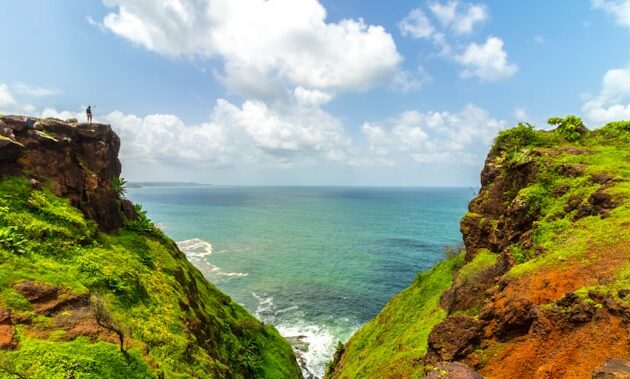
Nestled along the Konkan coastline of Maharashtra, Ratnagiri is a treasure trove of natural beauty, cultural richness, and agricultural abundance. From the famed Alphonso mango orchards to pristine beaches, lush green hills, and historic forts, this district offers an unforgettable escape into nature’s best-kept secrets. In this comprehensive guide, we take you through the natural wonders of Ratnagiri that make it a standout destination in India.
The Golden Harvest: Ratnagiri’s World-Famous Alphonso Mangoes
Ratnagiri is globally celebrated as the land of Alphonso mangoes, often referred to as the “King of Mangoes.” The region’s unique laterite soil, tropical climate, and skilled traditional farming practices contribute to the unparalleled sweetness, aroma, and texture of these mangoes.
Every summer, acres of lush mango orchards turn golden, yielding fruits that are not just a source of local pride but also a major export product. Tourists and connoisseurs flock to Ratnagiri during the harvest season to taste fresh Alphonsos, visit orchards, and even take part in mango-picking festivals.
Tranquil Escapes: The Serene Beaches of Ratnagiri

Ratnagiri’s coastline is dotted with unspoiled beaches, each offering a unique blend of beauty and tranquility.
Ganpatipule Beach
One of the most popular beach destinations in Maharashtra, Ganpatipule Beach is famous for its 400-year-old Ganpati temple, crystal-clear waters, and long stretches of white sand. It is a perfect mix of spirituality and serenity.
Bhatye Beach
Located just a few kilometers from the town of Ratnagiri, Bhatye Beach is ideal for evening strolls and breathtaking sunsets. The calm waves and scenic beauty make it a favorite among families and solo travelers alike.
Aare-Ware Beach
This twin beach stretch offers panoramic views of the Arabian Sea, nestled amidst winding coastal roads and forested hills. It’s relatively less crowded, making it ideal for those seeking solitude and a connection with nature.
Western Ghats Magic: Lush Hills and Waterfalls
Ratnagiri forms a significant part of the Western Ghats, a UNESCO World Heritage site. These ranges not only provide a majestic backdrop but are also home to rich biodiversity, hidden waterfalls, and trekking routes.
Marleshwar Waterfall
Hidden in the Sahyadri hills, Marleshwar Waterfall is a monsoon marvel surrounded by dense greenery. Nearby is the sacred Marleshwar temple, set within a cave, adding spiritual charm to the natural landscape.
Panhala and Vishalgad Fort Views
While technically near Kolhapur, these nearby hill forts offer expansive views of the Ratnagiri countryside and access to historical trekking routes through dense forests and ancient battlefields.
Rivers and Backwaters: A Hidden Waterway Paradise
While Kerala is famed for its backwaters, Ratnagiri’s rivers and estuaries offer a quieter yet equally captivating alternative. The Shastri River near Sangameshwar and the Kajali River near Rajapur form peaceful estuaries that support local livelihoods and eco-tourism.
Enjoy boat rides, kayaking, or simply watch as migratory birds make seasonal appearances in the mangrove forests lining these water bodies. It’s a paradise for birdwatchers and photographers.
Sacred Landmarks Amid Nature
Ratnagiri is not just about beaches and fruit orchards—it is also a land of spiritual retreats and ancient templesnestled in lush settings.
Velneshwar Temple and Beach
This quiet village offers both a picturesque beach and a historic Shiva temple, creating an atmosphere of serene devotion. It’s especially popular during Mahashivratri, when devotees gather for rituals and celebrations.
Parshuram Temple, Chiplun
Dedicated to Lord Parshuram, this hilltop temple provides panoramic views of the valley and is surrounded by scenic greenery. It holds mythological significance and is a key spiritual stop on any tour of Ratnagiri.
Marine Biodiversity and Conservation Initiatives
Ratnagiri is a hub for marine life and conservation, especially through its Marine Research and Conservation Centerlocated at Velas—a village known for the Olive Ridley turtle nesting sites.
Every year, locals and conservationists come together to protect these endangered turtles. The Velas Turtle Festivalallows visitors to witness baby turtles being released into the sea, promoting awareness and eco-tourism.
Rich History in Natural Settings: Forts of Ratnagiri
The coastline and hills of Ratnagiri are peppered with ancient forts, each narrating stories of Maratha valor, British colonization, and medieval dynasties.
Ratnadurg Fort
Overlooking the Arabian Sea, Ratnadurg Fort offers sweeping views of the coast. Surrounded by cliffs and waves, it’s a photographer’s delight and a historian’s muse.
Jaigad Fort
Perched near the Jaigad Creek, this fort is not only a military relic but also a vantage point to witness the confluence of river and sea. Nearby, the Jaigad Lighthouse gives tourists a panoramic view of the entire region.
Ecotourism and Sustainable Travel in Ratnagiri
There has been a growing focus on sustainable tourism practices in Ratnagiri. Agro-tourism, homestays, and eco-resorts allow visitors to immerse themselves in local culture while preserving the natural environment.
Many farms offer live experiences in mango picking, rice planting, and traditional Konkan cooking. Travelers looking to disconnect from urban chaos and reconnect with rural heritage will find Ratnagiri a rejuvenating retreat.
Conclusion: Nature’s Symphony in Every Corner of Ratnagiri
From the fragrance of ripening Alphonso mangoes to the soothing sound of waves crashing on untouched shores, Ratnagiri is more than just a destination—it’s an experience that engages all your senses. Whether you seek adventure, peace, or cultural insight, the natural wonders of this region promise to leave a lasting imprint on your soul.